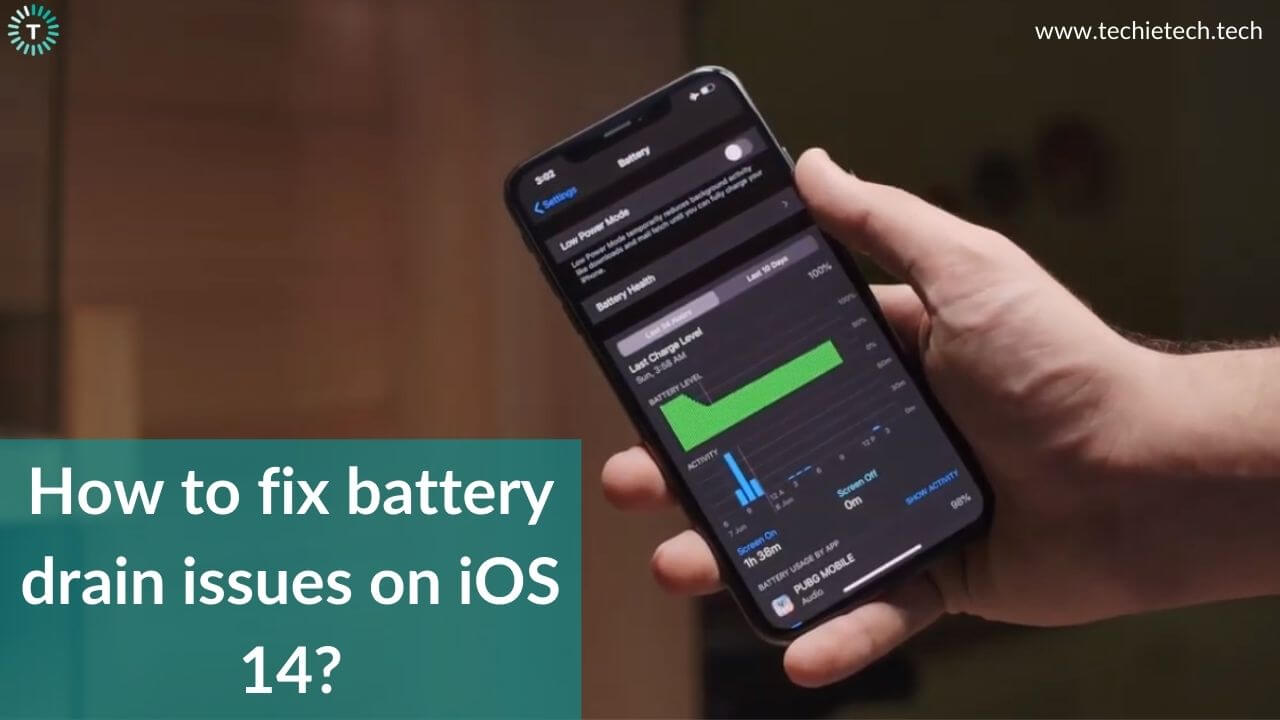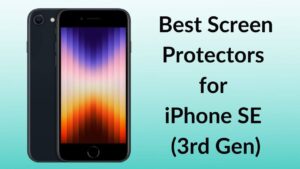Apple has introduced iOS 14 with a host of new features, including the ability to change the default web browser and email app on your iPhone. However, when a major update is released, it brings a swarm of bugs or issues on your phone. And, many users have reported battery drain issues after updating their iPhones to iOS 14. You may feel the battery life has reduced or drains abnormally overnight.
Don’t let the battery drain issues come in the way and spoil the amazing iOS 14 user experience. If you’re also facing similar problems, we are here to help you.
So, let’s get started with our troubleshooting guide on how to fix iOS 14 battery drain issues. It includes 15 productive methods that will surely help you make the most out of your iPhone’s battery. You can follow the mentioned steps for any iPhone model running iOS 14.
Disclaimer: Proceed at your own risk, TechieTechTech will not be responsible if anything goes wrong with your device.
15 Ways to fix iOS Battery drain issues
1. Check for Updates
If you’ve recently updated to iOS 14 and you’ve started facing battery drain issues, you must check for updates. The initial versions of iOS tend to be buggy, but Apple is quick to release important bug fixes and security patches to ensure a smoother performance on your iPhone. Therefore, it’s a great idea to make sure that your iPhone is running the latest stable version of iOS 14 (currently, iOS 14.2.1).
-
- Head to Settings > General
- Tap on the Software Update
- If any updates are available, download it
If the software is up to date, move to the other steps that we’ve mentioned below.
2. Reboot iPhone
If you’re facing battery drain issues on iOS 14, you must try rebooting your iPhone right now. This is one of the easiest and effective methods to fix battery drain, slow or no charging, or any other battery-related problems on any iPhone model. Many users have given this super-quick method a big thumbs up in fixing several issues on their smartphones. Therefore, don’t forget to try this hack. Turn OFF your iPhone, wait for about a minute, and then turn it ON. A reboot will help fix minor bugs and give a fresh start to your phone. Also, if improving the battery life and performance of your iPhone is a priority, make a habit of restarting your iPhone at regular intervals (once in a week is good).
3. Turn OFF Auto-brightness
Screen brightness has a huge impact on the battery life of your device. Many users have a habit of keeping the display of their iPhones at the maximum possible brightness, especially while playing games or watching series. But, this can be a huge drain on the battery. Also, if you put the display to auto-brightness, the screen brightness is adjusted using the built-in ambient light sensor. It will automatically adjust the brightness according to the surrounding light. The sensors will adjust the brightness even if there’s a slight change, and this can consume the battery unnecessarily. It’s worth knowing that if you keep your iPhone’s brightness over 50 percent while using it continuously, you might face
overheating issues on your iPhone.
Therefore, it’s good to turn OFF auto-brightness on your iPhone, especially when you’re indoors. To do this, head to Settings > Display & Brightness > Turn the slider OFF for Automatic.
You can head to the Control Center and adjust the brightness manually. Alternatively, you can also go to Settings > Display & Brightness and drag the slider to adjust the brightness.
You can switch to a lower brightness level that you’re comfortable with. Also, no need to go for a very dim display as it will do more harm than good. If you keep the brightness somewhere around 30-45 percent in ambient lighting, you’re sorted.
4. Turn OFF Background App Refresh
The Background App Refresh feature on iPhone allows apps to fetch content in the background, to ensure the app content, notifications are always up to date. This feature minimizes the lag time in displaying the updated data when you launch an app but consumes a considerable amount of power. If you’re facing excessive battery drain on iOS 14, you must disable Background App Refresh, and see the difference yourself.
For this, go to Settings > General > Background App Refresh, and select OFF.
In case you wish to enable Background App Refresh for some apps like Google Photos, Google Drive, Dropbox, OneDrive, or any other app where you constantly upload media in the background, you can select the upload only on Wi-Fi option. It will help you conserve battery to some extent. But again, make sure to disable Background App Refresh for all the other apps that need not be updated all the time. Social media apps like FaceBook, Instagram, and others are already known to have a huge impact on battery life. Therefore, if you want to fix iOS 14 battery drain issues, make sure to disable Background App Refresh for all social media and eCommerce apps.
5. Enable Low Power Mode
The Low Power Mode will reduce power consumption on your iPhone by reducing or disabling some features like automatic iCloud uploads, background app refresh, auto-lock, some visual effects, email fetch, etc. Therefore, some features may take longer to update or complete, but the Low Power Mode is definitely a savior in those terrible situations when you’re running on a low battery, and there’s no way to charge your iPhone. If you’re facing battery drain issues on your iPhone running iOS 14, you can also enable Low Power Mode as it can give you an additional two to three hours of battery life.
You can follow either of the methods to enable Low Power Mode on iOS 14:
- Head to the Control Center and tap the battery icon. The battery icon should turn yellow.
- Go to Settings > Battery and turn the slider ON for Low Power Mode. Now, the battery icon should turn yellow.
After you charge your iPhone to 80 percent or higher, the Low Power Mode will be disabled automatically, and the battery icon will turn green.
6. Disable Location Services
Many smartphone users have a habit of keeping the location services ON on their phones all the time, whether they actually need it or not. If you’re one of them, this is a must-follow hack for you.
It’s worth knowing that apps using Location Services can make a huge impact on the battery life of your iPhone. Location Services is one of the biggest battery killers on any smartphone. If you keep Location Services ON all the time, it can drain the battery in no time. Therefore, if you’re facing battery drain issues on iOS 14, we recommend you to tweak the Location Services on your iPhone. Head to
Settings > Privacy > Location Services, you can either turn the location services OFF or choose to allow an app to access your location while using the app. If you select the latter option, an app can access your location only when you’ve opened or are actively using a particular app. This can be particularly useful for apps like Google Maps, App Store, and others that do not require location services all the time.
So, make sure to disable Location Services on your iPhone (whenever you don’t need it), you’ll surely see a positive change in the battery life of your iPhone.
7. Enable Dark Mode
If you’ve got an iPhone with an OLED screen like the iPhone X, XS, XS Max, or 11 Pro, switching over to Dark Mode can help in improving battery life on your device. This is because an OLED screen consumes less power to emit dark colors than bright ones. Also, the OLED displays light up every individual pixel to create an image, as compared to the whole display on iPhones with LCD displays. When you switch to Dark Mode, the display shuts off the pixels that show black color. Besides giving you more battery life, Dark Mode also offers a great viewing experience with deeper blacks and brighter whites. Therefore, it’s a win-win situation for you.
It’s worth mentioning that all the models of the latest iPhone 12 Series- iPhone 12, 12 Mini, iPhone 12 Pro, and 12 Pro Max boast a Super Retina XDR OLED display.
To enable Dark Mode, go to Control Center, press and hold the brightness control, and tap Dark Mode. Alternatively, you can head to Settings > Display & Brightness and Tap Dark. You can either set Dark Mode on your iPhone automatically from Sunset to Sunrise or set a schedule as per your needs.
8. Use Wi-Fi over Mobile Data
If you’re really serious about improving battery life on your iPhone running iOS 14, make a habit of using a Wi-Fi network over Mobile Data, whenever possible. Now, that doesn’t mean you should always keep the Wi-Fi turned ON. When there’s no Wi-Fi network available or when you don’t need it, you must turn OFF Wi-Fi on your iPhone to save battery. We are saying this because if you’ve turned ON Wi-Fi and there’s no Wi-Fi network available, your iPhone will keep searching for a network, and this will consume battery. If you face an unusual battery drain on iOS 14, make a habit of disabling all the features that you don’t need. We’ve talked about this in detail, in the next step.
Also read: WiFi not working on iPhone? Here’s how to fix it
9. Adjust Network Settings
Besides Wi-Fi, there are several other features which you must turn OFF when they are not in use. We are talking about Bluetooth, Mobile Data, and GPS (which we’ve already mentioned in step 4). When you make a habit of turning OFF all the features that you don’t need currently, you’ll surely see a positive change in the battery life of your iPhone. Moreover, when you’ve updated your iPhone to iOS 14, and you notice an abnormal battery drain, you must observe the way in which you’re using your iPhone. Playing games or watching movies at a stretch, especially on mobile data can drain the battery significantly. Plus, you can also run your iPhone or any other smartphone into
overheating issues. So, when you’re looking for ways to fix the battery drain on iOS 14, first make sure that you aren’t keeping any features turned ON unnecessarily or doing battery-consuming tasks at a stretch.
Coming to another major reason for battery drain issues on iOS 14. We know that the entire lineup of iPhone 12 series- iPhone 12, 12 Mini, 12 Pro, and 12 Pro Max has support for 5G networks. If you keep 5G ON all the time, it can drain the battery in no time. Many users have noticed that the battery drains faster on 5G than LTE networks. Fortunately, Apple has given its users control over your iPhone’s 5G connection. Therefore
, if your network carrier doesn’t support 5G, or if you live in an area where there’s no 5G network coverage, there’s no point in keeping 5G turned ON all the time. In such cases, it’s better to switch to 4G/LTE networks. For this, head to Settings > Cellular > Cellular Data options > Voice and Data and tap LTE.
We would also like to talk about another major yet easily overlooked reason for facing battery drain issues on iOS 14. Sometimes, you may feel that you’re facing battery drain issues on your iPhone because you’ve updated to iOS 14, but the actual reason may not be related to this at all. Whenever you notice there’s a poor network or you get No Service on your iPhone, make sure to put your phone on Airplane mode. See, when there’s a poor network, you’ll anyway not be able to use your phone, so it’s better to put it on Airplane mode and save battery. You can use a Wi-Fi network in those situations. The most common example of these situations is a basement or an area where there’s a bad network at all times. We’ve explicitly mentioned it because, in such cases, your phone will constantly try to find and connect to a network, and it will lead to more battery drain. And, this is one of the most easily overlooked and hard to find causes of the battery drain on your iPhone running iOS 14.
10. Turn OFF Raise to Wake
The Raise to Wake feature automatically turns ON your iPhone’s display every time you pick up your phone and it’s facing towards you. This feature allows you to check notifications, time, or any other info, without using the power button.
But along with the convenience, this feature also brings a disadvantage. It can drain the battery unnecessarily on your iPhone. When you’ve got your iPhone in your hand, and you’re walking, the display can turn ON automatically, and drain the battery. Though it doesn’t make a huge impact, if you’re facing abnormal battery drain issues on iOS 14, you must take all the little steps that can make a huge difference, when put together.
Therefore, turn OFF raise to Wake to save some battery on your iPhone. Go to Settings > Display & Brightness > Raise to Wake > Toggle Off.
Now, coming to another worth-considering aspect. You would have noticed that after you’ve checked your phone and put it down, the display can stay ON for 1, 2, or 5 minutes until the screen turns off by itself. This draws a lot of power. It is known as Auto-lock in iPhone, and if configured properly, it can help you save a lot of battery. Adjust the Auto-lock to 30 seconds, this will help you get rid of battery drain issues on iOS 14.For this, head to
Settings > Display & Brightness > Auto-lock and select 30 seconds.
11. Disable Dynamic/ Live Wallpapers
If there’s a noticeable battery drain on your iPhone after upgrading to iOS 14, you must disable Dynamic or Live wallpapers and switch to the regular ones. This is because dynamic wallpapers will move continuously based on the movement of your device, and this consumes more battery on your iPhone. Live wallpapers are activated (shows animation) when you use a 3D Touch on the wallpaper. To avoid unnecessary battery drain, disable dynamic or live wallpapers, and choose a still or an image from the Photo Library.Go to Settings > Wallpaper > Choose a New Wallpaper. Now, either choose an option from Stills or select an image from your Photos.
12. Check Battery Health
You must keep a regular watch on your iPhone’s battery health. This is because Lithium-ion batteries do wear out over time and need replacement. Battery Health is a built-in feature in iOS 11.3 and later that gives you information about the iPhone’s maximum capacity and peak performance capability. The maximum battery capacity measures the iPhone’s battery capacity relative to when it was new. As the battery chemically ages, it will show lower capacity which may result in fewer hours of usage between charges. Also, as the battery degrades, it won’t be able to deliver peak performance. Battery Health will also inform you if your iPhone’s battery needs to be replaced or requires service. So, you must make a habit of keeping a watch on the battery health of your iPhone.
Also, if you’re facing battery drain issues or any other issues related to the battery like if your iPhone is not charging, you must check the battery health of your device. Head to Settings > Battery > Battery Health and check the Maximum capacity. The lower battery capacity will give you fewer hours of usage between charges.
If the maximum capacity has gone below 70 percent, you may need to replace the battery. If the maximum charging capacity of your iPhone’s battery is around 80-90 percent or even more, and you’re still facing battery drain issues, move on to the next steps
.
Also read: How to improve battery health of any iPhone
13. Check your Apps
If an app is drawing excessive battery, it’s burdensome for your iPhone’s CPU as well as battery. And, this may cause various problems on your iPhone like overheating or battery drain issues.
You must identify those apps and get rid of them as soon as possible. Head to Settings > Battery and you’ll see the battery consumption by different apps. Now, you must identify and quit the apps that are using the most battery life, and ultimately cause abnormal battery drain on your iPhone.
Also, make sure that the apps on your iPhone are up to date. Developers keep adding new features and fix existing bugs via updates. But, make sure to
go through the most recent reviews before updating your apps. This is because some newly added functionalities can introduce bugs that can further affect your iPhone’s performance and battery health.
To update apps on your iPhone, follow the steps mentioned below:
- Head to the App Store.
- Tap on the Today tab at the bottom of your screen.
- Click on the user profile present on the top-right corner of your screen.
- You’ll see your account details.
- Scroll down to the section of the available updates.
- You can tap a particular app to update it or can even update all the apps at once by tapping on the Update All option.
14. Reset All Settings on your iPhone
If nothing has helped you fix iOS 14 battery drain issues, you can try resetting all settings on your iPhone. When you face battery or performance-related issues on your iPhone after updating iOS on your device, you can reset all settings to get rid of such problems. After you’ve reset all settings, your iPhone will
load up the default settings. It’s worth mentioning that this method will not delete any media or files on your iPhone, it will simply clear all the settings and details related to websites, Wi-Fi networks, and Bluetooth connections. So, you need not backup any data. Just make sure to note down the Wi-Fi password as you would have to enter that again.
Follow the steps mentioned below to reset all settings on your iPhone:
- Go to Settings > General
- Scroll to the bottom and tap Reset
- Tap Reset All Settings
- Enter the passcode
- Confirm to reset all settings on your iPhone.
15. Downgrade/Restore
If you’ve upgraded your iPhone to the latest version of iOS 14, and you’re facing issues like unusual battery drain, Safari not working, or your iPhone has become slow, or some apps are crashing on your iPhone, and you don’t want to wait for the next update, you can downgrade to iOS. Don’t jump directly to this step, make sure to try all the other methods to fix iOS 14 battery drain problems.
Now, it’s worth knowing that you simply can’t downgrade from iOS 14 to iOS 13 as Apple has stopped signing iOS 13. But, if you’ve updated to iOS 14.2 and you feel that you’re facing more problems, you can downgrade from the newer version of iOS 14 to the older version of iOS 14.
Before we jump to the steps, we would like to list a few important points here:
- All your photos, media, contacts, and everything else will be deleted. So, make sure to backup all your iPhone data.
- If your iPhone has automatically backed up via iCloud since you’ve upgraded, you won’t be able to access any of your data after downgrading. You’ll have to start again or restore from an older backup.
- Check if Apple is signing the older version of iOS.
- You must also understand the risks associated with downgrading iOS on your iPhone. If Apple has stopped signing the iOS version and you still try to install it, you may lose all data on your iPhone, and the latest version of iOS will be installed on your device.
Therefore, make sure to do proper home-work before you try downgrading iOS on your iPhone. When you feel you’re ready to take the risk, follow the steps mentioned below:
- Open the Finder or iTunes.
- Download the older iOS software update. Make sure to use a safe site for this. You can check one here. Make sure to download the software for your device or else the restore will fail.
- Connect your iPhone running iOS 14 to your Mac/laptop using a Lightning cable. Select your iPhone from the menu.
- Click Restore iPhone while holding down the Option/Alt key on your Mac or the Shift key on your Windows PC and locate the IPSW file that you’ve downloaded in step 2.
- After you’ve selected the file, it should be verified, extracted, and loaded onto your iPhone.
That’s it! Now, you’ll see the older iOS welcome screen on your iPhone.
You can also restore your iPhone as new. For this, you’ll first need to backup your iPhone data. Many iOS users have noticed a significant improvement in battery life after setting up their iPhones as new. To know more details on how to restore an iPhone,
Looking for the correct way to fix a faulty iPhone battery? Check out our guide on how to calibrate your iPhone’s battery.
That was all from our side on how to fix iOS 14 battery drain issues. We hope this troubleshooting guide has helped you fix those issues and help extend battery life on your iPhones.
What are your views on iOS 14? Here’s our quick review of iOS 14 on iPhone XS Max.




